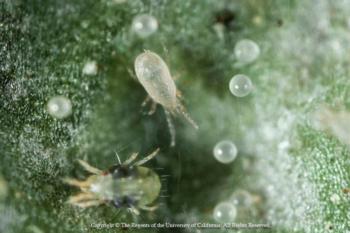Unused stories
Pest of the Month - Spider mites
They're not really spiders...

These common pests feast on fruit trees, vines, berries, vegetables, and ornamental plants particularly June through September. Also called webspinning mites, they are among the most ubiquitous of all pests in the garden. The two-spotted spider mite and the Pacific spider mite are the most prevalent in our area. They thrive in low rainfall areas of the West where warm summer temperatures above 70°F and dry plant foliage favor their development. Their populations can build up to tremendous numbers and can decimate a plant in a very short time if the conditions are right - hot, dry weather and dust and dirt on leaf surfaces.
You’ll usually see plant damage first – stippling or yellowing of leaves, before seeing the mites themselves. As feeding continues, leaves turn yellow and drop off. Check the undersides of leaves for mites, their eggs, and webbing. Shake a few off the leaf surface onto a white sheet of paper; if you dark specks moving across the paper, it’s most likely spider mites.
Spider mites have a number of natural enemies including the six spotted thrips, the larvae and adults of the spider mite destroyer lady beetle and predatory mites along with general garden predators like minute pirate bugs, bigeyed bugs, and lacewings. The best protection against an invasion of mites is maintaining good cultural practices. Remove fallen leaves, branches or fruit, as well as weeds that may serve as a host for them. Keep plants well watered and apply mulch to minimize plant stress. Periodic hosing of plants with a forceful jet of water, including the undersides of leaves, can physically dislodge and kill many mites as well as remove the dust that collects on foliage and interferes with mite predators.
If a treatment for mites is necessary, use selective materials, preferably insecticidal soap, horticultural oil or neem oil. Ensure that plants are well hydrated before applying any chemicals. Chemical control of spider mites generally involves pesticides that are specifically developed for spider mite control (miticides or acaricides). Few insecticides are effective for spider mites and many even aggravate problems. Severe outbreaks of spider mites can occur after the use of a general insecticide, one that kills off many of these natural enemies and stimulates the mite’s reproduction. When using any chemical, be sure to read the label and follow the manufacturer’s direction; and dress appropriately for the occasion – wear protective clothing.
By Nanette Londeree
